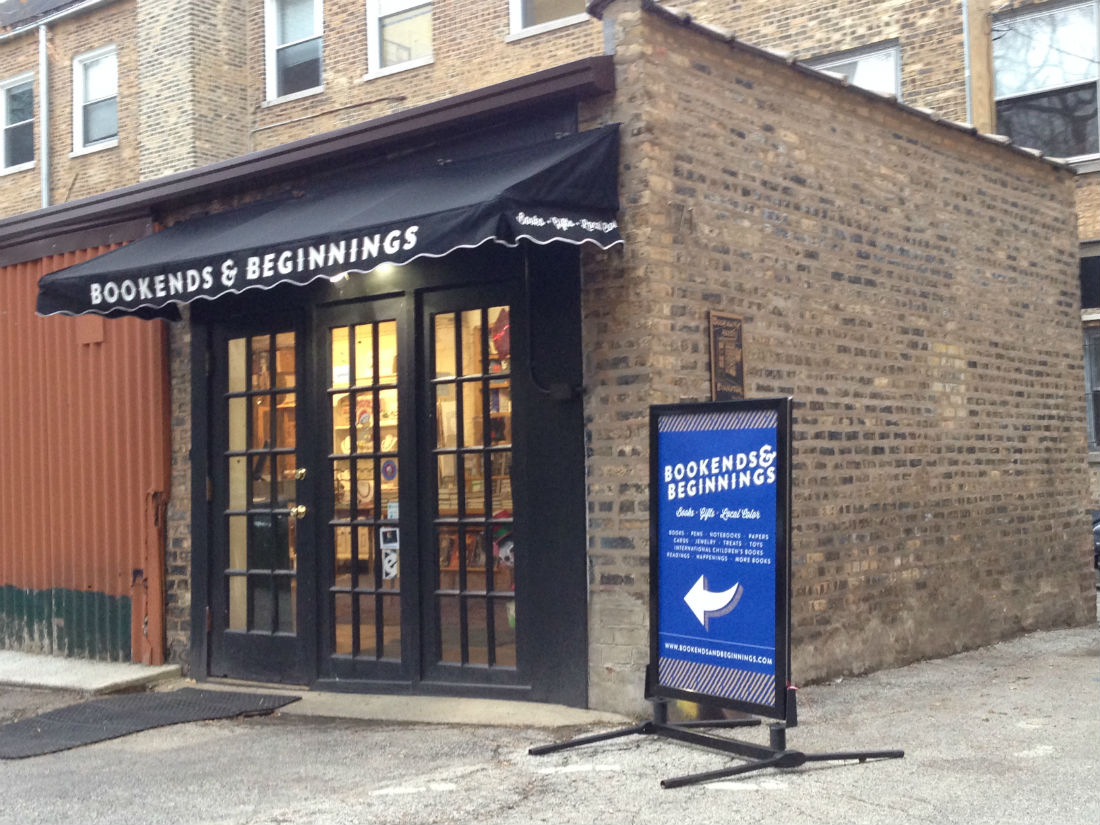By Alex Valentine
Tucked neatly into an alleyway between Sherman and Benson Avenue sits Bookends and Beginnings, Evanston’s only independent bookstore. With a narrow brick exterior and a deceptively large interior, it would fit nicely in Harry Potter’s Diagon Alley.
Evanston bookworms mourned when the building’s former resident, Bookman’s Alley, closed in October 2013, after 33 years in business. Bookman’s Alley was such a community staple that author Audrey Niffenegger mentioned it in her 2003 bestseller, The Time Traveler’s Wife.
The following summer, Nina Barrett and her husband, Jeff Garrett jumped at the opportunity to take over the tenancy of the bookstore.
“It’s an interesting time for bookstores,” said Barrett. “Ten years ago, I wouldn’t have considered opening one. But the time was right.”
Evanston, like many other U.S. cities, had two major retail bookstores for years – Borders and Barnes & Noble. But online competition from Amazon crippled the two chains’ brick-and-mortar business model.
Borders went out of business and shuttered all 511 of its U.S. stores in 2011, and Barnes & Noble is struggling mightily to keep its head above water. The New York City-based bookstore reported a third consecutive loss for the latest quarter on Thursday, and its stock price of $10.04 is down 26 percent from a year ago.
As of March 2014, Amazon had a 41 percent market share of all new book purchases, including a 65 percent share of online book purchases.
But Bookends and Beginnings is in a market segment that has been able to fight off online competition, and is thriving now that corporate bookstore competition has waned.
“We attract a certain kind of reader who still wants to touch a physical book, and misses the ‘bookstore experience,’” said Barrett. The bookstore’s best sellers are typically older, quirky books, and are rarely New York Times bestsellers.
For several years, the future of independent bookstores didn’t look so promising.
The number of independent bookstores in the U.S. plummeted from around 4,000 in the early 1990s to about 1,800 in 2006, largely because of the growth of Borders and Barnes & Noble. In the 1990s alone, Borders went from 21 bookstores to 256 superstores.
“For a long time, from 1992 to 2002, you literally could count on two hands the number of [independent bookstore] openings,” Oren Teicher, CEO of the American Booksellers Association, told USA Today in 2006.
However, ABA data shows the number of independent bookstores in the U.S. has rebounded over the past six years by 35 percent, up to 2,227 as of November 2015. In 2014, year-over-year book sales were up nationally in 47 out of 52 weeks.
[field name=”Independent Book Stores”]
“We’ve all been to the big box stores, and it’s the same thing every time,” said Linda Kruhmin of Evanston, a frequent Bookends and Beginnings customer. “I feel good about the money I spend here. Even if I’m not interested in a subject, I’ll pull out a book, and it’ll pique my interest. This is where I come to forget about all of the problems in the outside world.”
That type of unique connection between small bookstores and their customers is the catalyst behind independent bookstores’ resurgence.
Bookends and Beginnings has a rewards system that gives customers 5 percent off for every $100 spent at the store. Attached to several books are reviews, written by one of the store’s six employees – a common practice at many independent bookstores.
“Our customers are passionate about reading, and they want to take recommendations from other avid readers,” said Barrett.
Barrett says independent book stores aim for a 2 percent profit margin, but that many lose 2 percent or more annually.
When Barrett and her husband first opened Bookends and Beginnings, they bought 10,000 used books and started with a small inventory, which helped them avoid an initial loss that would have been difficult to overcome.
“We’re still in our second year, and we don’t expect to make money for the first two years, just like any other business,” said Barrett.
Still, she said sales are running consistently higher by 40-50 percent from a year ago. Customers flocked to the store for the annual “Small Business Saturday,” a nationally recognized day for shopping at local businesses, which is sandwiched between Black Friday and Cyber Monday.
Last year, sales tapered off after Small Business Saturday, until the final weeks before Christmas. But this year, Barrett says sales have been much more consistent during the lull between the bookstore’s two busiest times.
While that’s a hopeful sign for Bookends and Beginnings and other independent bookstores’ staying power, Barrett still worries about the impact of Amazon’s low prices on the future of the publishing industry.
For example, Shea Serrano’s The Rap Yearbook, a New York Times bestseller, is sold at Bookends and Beginnings for a retail price of $18.95 before tax. The same book is $11.37 on Amazon.
Barrett says prices that low create an unsustainable publishing process.
“It’s much like the difference between farm-to-table restaurants and fast food,” said Barrett. “You pay more for the product, but you’re also paying for the process that’s behind the scenes. There are too many people who need to be paid in the bookmaking business to charge that much below retail value.”

